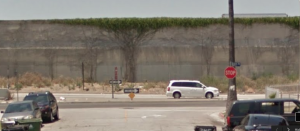In the interview with Helena Viramontes, she describes East LA as being ostracized and excluded from the rest of society. This social distance is also present, both literally and figuratively, in the novel. In a literal sense, the city faced exclusion when it was quarantined due to an outbreak of rabies, but in a figurative sense, one can infer this is also reveals the exclusion of this community due it’s lower economic status and crime. The picture above is of a residential street on Broadway and 78th street. I attend church across the street and always noticed how the freeway ran right through the street. Before reading the novel, I never knew anything about the history of the freeway construction. I always found it odd how the freeway looked more like a wall than a freeway and the novel helped me understand the history behind it. Has anyone else felt this way too?


I think one of the implications of freeway construction, such as the one in your picture, is that freeways make towns less “home-like” and more “business-like.” Freeways are a paradigm of industrialism, economic strength, expansion, efficiency, and so on. Freeways create small-towns into places where major industrial projects are; they make towns loud, more polluted, have higher traffic, and overall a decrease in the sense of communal family. I think the wall in your picture does a fantastic job of portraying how freeways have the ability to segregate parts of town, such as with the dead-ends within our novel that Tranquilina experiences. Freeways and other large industrial projects, such a skyscrapers, railroads, airports, all make towns more mechanical and systematic — this, taking away from the special connection one may find with a quiet hometown.
I too find it ironic the ostracizing affect freeways and other instruments of industrialism can have on the surrounding community. As mechanisms of transportation, it seems freeways should inherently foster accessibility, connecting communities that would otherwise be disconnected from one another and allowing for resources to flow. In Viramontes’s novel, however, the 110 together with the medical quarantine have a restricting influence on the characters and the East Los Angeles community, furthering their socio-economic disparity. I too have experienced the construction of a freeway through an already existing community when the 210 freeway was built just behind my house. Since its construction, however, it has acted as catalyst for infrastructure and aided growth in the surrounding cities, far differing from the influence of the 110 in “Their Dogs Came With Them”.
After reading “Their Dogs Came with Them,” one can conclude that the four main characters Ermila, Tranquilina, Ana, and Turtle correlate with structure in which the 110 freeway is constructed.
Years ago, after speaking with a construction worker, I came to learn that sometimes freeways have tall wall so that drivers wont be deterred by the outside community.
It is interesting to see how the Quarantine described in the novel, served as barrier that excluded residents of East Los Angeles, and how the wall of the freeway also serve as barrios.